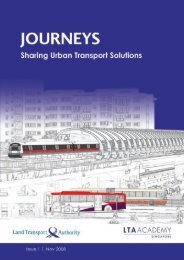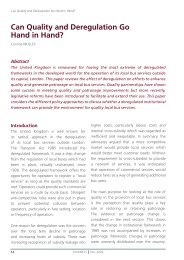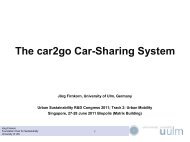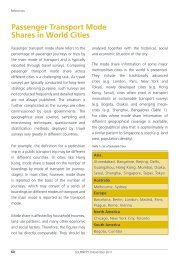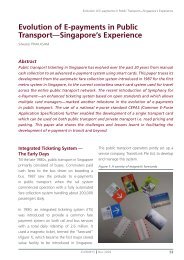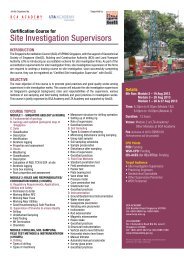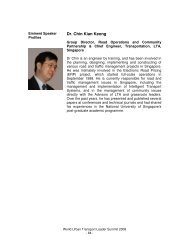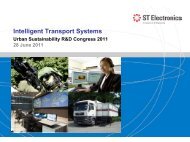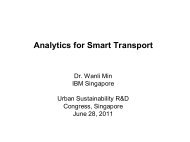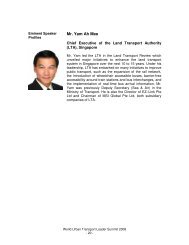Issue 4 May 2010 - LTA Academy
Issue 4 May 2010 - LTA Academy
Issue 4 May 2010 - LTA Academy
You also want an ePaper? Increase the reach of your titles
YUMPU automatically turns print PDFs into web optimized ePapers that Google loves.
Urban Transportation Planning for a Vibrant and Distinctive Singapore<br />
on fossil-fuelled two-wheelers in metropolitan<br />
zones within China (Wienert 2008). The last<br />
factor is widely understood to be crucial to<br />
the rapid increase in demand for electrical<br />
replacements; consumers are simply turning<br />
to the most viable alternatives. This is a<br />
tough lesson for other countries seeking to<br />
adopt EV fleets: is the law as a stick the best<br />
encouragement for change?<br />
How would Singapore do? The China and<br />
Taiwan approach is likely to be unpalatable to<br />
proponents of market-based solutions who<br />
prefer to see consumers switching to EVs on<br />
their own accord (Wienert 2008). A legal ban on<br />
ICEVs on segments of Singapore roads would<br />
raise many questions (and many possibilities.)<br />
But a multi-government agency with a wholeof-government<br />
approach would have to be<br />
first established to provide options, e.g., rapidly<br />
engineer the electrical-charging infrastructure<br />
necessary to keep the EVs and electric bicycles<br />
on those segments of road. While the EV<br />
test-bedding programme is a good start, the<br />
entire car re-sale market would have to be<br />
actively tweaked by the government in order<br />
for existing car owners to gradually phase out<br />
their current vehicles; an ample adjustment<br />
period to alleviate any economic woes caused<br />
by the new policies is needed. Major cardealers<br />
and parallel importers would have to<br />
be persuaded to market EVs (Figure 4). And<br />
how is this to be achieved? We suggest that a<br />
study of the politics of subsidies and incentives<br />
and economic policy be expedited to ensure<br />
mass consumer confidence in new products,<br />
new systems, new technologies, given that<br />
there remains many rate-limiting steps, such<br />
46<br />
JOURNEYS <strong>May</strong> <strong>2010</strong><br />
as improvements needed in energy storage<br />
systems and systems for better monitoring<br />
and control of power flows within the vehicle<br />
and from grid-to-vehicle (G2V) and from V2G<br />
(Anderson 2009). Singapore could emerge as<br />
an international leader in the implementation<br />
(test-bedding) of EV technology with its<br />
attendant corporate consulting benefits and<br />
R&D leadership. However, the social-economic<br />
costs in doing so must be well-considered.<br />
Figure 4: Electric Vehicle on sale (Nissan Leaf)<br />
In Singapore, the current view is that through a<br />
system of government-sponsored and private<br />
sector-driven corporate incentives, the sticker<br />
price of any EV (HEVs, PHEVs, or EVs) would<br />
decline to levels palatable to the average<br />
motorist. The Chinese experience with E2Ws<br />
indicates that short of an outright ban on<br />
ICEVs, the public was unprepared to accept<br />
EVs as a general rule; one author has termed it<br />
“a policy accident, rather than success” (Yang<br />
<strong>2010</strong>). In Taiwan, motorists were not prepared<br />
to accept EVs even when prices were on par<br />
or below that of conventional cars, motorbikes<br />
and scooters (Yang <strong>2010</strong>). The PHEV combines<br />
the positive attributes of EVs and the ICE,<br />
but in the event where the driver forgets to<br />
charge the vehicle over-night, the efficiency<br />
factor of a PHEV plummets as the battery



